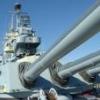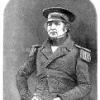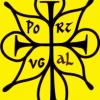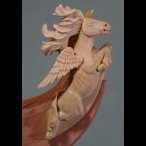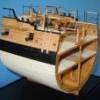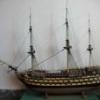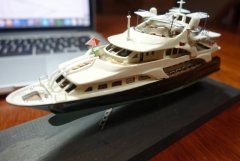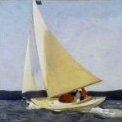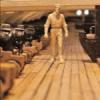-
Posts
13,092 -
Joined
-
Last visited
Reputation Activity
-
 druxey reacted to Dan Vadas in Driver Boom on 6th Rates 1776 ?
druxey reacted to Dan Vadas in Driver Boom on 6th Rates 1776 ?
Hmm, now you mention it so it does regarding the Driver Boom. However no mention was made about the Mizzen Topmast on the plans . Ah well, "Vulture" was a bit experimental in other areas - I'll leave the Mizzen Topmast as is and leave out the Driver Boom. Vulture lasted into the 19th century, so I'll call this the 1792 version .
Danny
-
 druxey reacted to EdT in Young America 1853 by EdT - FINISHED - extreme clipper
druxey reacted to EdT in Young America 1853 by EdT - FINISHED - extreme clipper
William L. Crothers
I am very sorry to report that Bill Crothers passed away on Friday, May 1. He was in his 103rd year. Bill’s research and writings on American clippers and packets, in particular his intensive exploration of the structures of these ships, place him at the forefront of contributors to our knowledge of these subjects. I am personally indebted to him, for without his work there would be no framed Young America model, nor perhaps more excellent examples to follow. It was my special privilege to have briefly known Bill and to have his valuable comments on my work. I will always value the interest he showed in the model, no less than the writings that made it possible.
Ed
-
 druxey got a reaction from augie in First time rigging - being organized
druxey got a reaction from augie in First time rigging - being organized
Before one has rigged a model, the task seems utterly daunting. This is Stage 1, where you are at. Take a deep breath and get yourself centered.
Rigging is essentially a logical exercise. This should, as a software engineer, reassure you. Every line has a purpose and function, even if this is not immediately apparent.
Begin with the standing rigging, lower first, working from forward to aft. If in doubt, there is plenty of help available on this forum.
We all began our rigging experience at Stage 1 (see above).
-
 druxey got a reaction from JerseyCity Frankie in Possible new technique for making sails.
druxey got a reaction from JerseyCity Frankie in Possible new technique for making sails.
With due respect to the model sailmakers out there: any stitching at scales under about 1:6 looks way over-size, as Wefalck has said.
-
 druxey got a reaction from Erebus and Terror in HMS Terror by Erebus and Terror - FINISHED - Scale 1:48 - POB - as fitted for polar service in 1845
druxey got a reaction from Erebus and Terror in HMS Terror by Erebus and Terror - FINISHED - Scale 1:48 - POB - as fitted for polar service in 1845
Heh, heh. And tomorrow, the world! Actually, I'd need to learn a suitable CAD program first before scorching any wood. Sorry about your scroll saw, E&T. I hope you got good mileage out of it before it quit.
-
 druxey got a reaction from rybakov in First time rigging - being organized
druxey got a reaction from rybakov in First time rigging - being organized
Before one has rigged a model, the task seems utterly daunting. This is Stage 1, where you are at. Take a deep breath and get yourself centered.
Rigging is essentially a logical exercise. This should, as a software engineer, reassure you. Every line has a purpose and function, even if this is not immediately apparent.
Begin with the standing rigging, lower first, working from forward to aft. If in doubt, there is plenty of help available on this forum.
We all began our rigging experience at Stage 1 (see above).
-
 druxey got a reaction from Canute in First time rigging - being organized
druxey got a reaction from Canute in First time rigging - being organized
Before one has rigged a model, the task seems utterly daunting. This is Stage 1, where you are at. Take a deep breath and get yourself centered.
Rigging is essentially a logical exercise. This should, as a software engineer, reassure you. Every line has a purpose and function, even if this is not immediately apparent.
Begin with the standing rigging, lower first, working from forward to aft. If in doubt, there is plenty of help available on this forum.
We all began our rigging experience at Stage 1 (see above).
-
 druxey got a reaction from Trussben in HMS Pegasus 1776 by Trussben - 1:48 - Swan-class sloop based on TFFM
druxey got a reaction from Trussben in HMS Pegasus 1776 by Trussben - 1:48 - Swan-class sloop based on TFFM
Nice! I like the run of the floor fillers.
-
 druxey reacted to Trussben in HMS Pegasus 1776 by Trussben - 1:48 - Swan-class sloop based on TFFM
druxey reacted to Trussben in HMS Pegasus 1776 by Trussben - 1:48 - Swan-class sloop based on TFFM
Here are all 5 pieces of the keelson scarphed together and installed.
They were also bolted down through every floor timber with 1 1/4" "bamboo" bolts.
Now the Stemson needs to be made.
Ben
-
 druxey got a reaction from dvm27 in First time rigging - being organized
druxey got a reaction from dvm27 in First time rigging - being organized
Before one has rigged a model, the task seems utterly daunting. This is Stage 1, where you are at. Take a deep breath and get yourself centered.
Rigging is essentially a logical exercise. This should, as a software engineer, reassure you. Every line has a purpose and function, even if this is not immediately apparent.
Begin with the standing rigging, lower first, working from forward to aft. If in doubt, there is plenty of help available on this forum.
We all began our rigging experience at Stage 1 (see above).
-
 druxey got a reaction from gjdale in First time rigging - being organized
druxey got a reaction from gjdale in First time rigging - being organized
Before one has rigged a model, the task seems utterly daunting. This is Stage 1, where you are at. Take a deep breath and get yourself centered.
Rigging is essentially a logical exercise. This should, as a software engineer, reassure you. Every line has a purpose and function, even if this is not immediately apparent.
Begin with the standing rigging, lower first, working from forward to aft. If in doubt, there is plenty of help available on this forum.
We all began our rigging experience at Stage 1 (see above).
-
 druxey got a reaction from Omega1234 in 24' gaff-rigged ketch by vaddoc - FINISHED - Scale 1:12- exploration - a Tad Roberts design
druxey got a reaction from Omega1234 in 24' gaff-rigged ketch by vaddoc - FINISHED - Scale 1:12- exploration - a Tad Roberts design
Acrylic/latex caulking is good as it will take paint, whereas silicon will not. As it is not really sandable when dry, you will need to apply it carefully and wipe it with a damp piece of paper towel to smooth it.
-
 druxey got a reaction from Jay 1 in Possible new technique for making sails.
druxey got a reaction from Jay 1 in Possible new technique for making sails.
There is a new technique for making sails described in the revised TFFM, Volume IV. (The relevant information is also available as a separate booklet form SeaWatch Books.) The results can be seen on the 'workshops' page of Admiralty Models. You can see for yourself how this looks.
-
 druxey reacted to RichardG in Windlass on 1815 Revenue cutter
druxey reacted to RichardG in Windlass on 1815 Revenue cutter
Thanks druxey and Joel.
Chuck's windlass is definitely an inspiration. The scale is close enough to mine that I had considered just buying one from him. However unless something I need is beyond my skill level and/or I don't have the equipment needed, I will try to build it myself first. In this case mine won't be as good but hopefully it will be good enough, if not, I can change my mind (again!). I have already purchased rope and blocks from Chuck, so I know the quality is there.
Richard.
-
 druxey reacted to dvm27 in HMS Pegasus 1776 by Trussben - 1:48 - Swan-class sloop based on TFFM
druxey reacted to dvm27 in HMS Pegasus 1776 by Trussben - 1:48 - Swan-class sloop based on TFFM
Looking great, Ben. I actually made the fore and aft sections before framing as it was easy to transfer the bottom shapes this way.
-
 druxey got a reaction from Erebus and Terror in HMS Terror by Erebus and Terror - FINISHED - Scale 1:48 - POB - as fitted for polar service in 1845
druxey got a reaction from Erebus and Terror in HMS Terror by Erebus and Terror - FINISHED - Scale 1:48 - POB - as fitted for polar service in 1845
Nice use of the free library technology! Where do you live? I'll be right over! Everything on the hull lines up beautifully.
-
 druxey reacted to Jeronimo in THE 74-GUN SHIP by Jeronimo
druxey reacted to Jeronimo in THE 74-GUN SHIP by Jeronimo
Hello friends,
my next project in the planning:
The 74 GUN-SHIP
" L E C E N T A U R E 1783 "
after the plan drawwings of:
Jean Boudriot, publishing company ANCRE, France.
Timbering Plans of
Jean C. Lemineur
as well as numerous photos and pictures of the construction of his 74 GUN -SHIP
Gaetan Bordeleau, Canada
I here with once again warmly thanks.
The construction of the rear section is planned as a cross section model with complete inside removal.
Scale : 1 : 48
NEW : 1 : 36
Type of wood : Deutsche Elsbeere
Karl
Hi friends.
Link: all photos during the construction phase:
https://cloud.web.de/ngcloud/external?locale=de&guestToken=22n438epR2m22PUrLw7l4A&loginName=karl.weinmann#/_
-
 druxey reacted to Erebus and Terror in HMS Terror by Erebus and Terror - FINISHED - Scale 1:48 - POB - as fitted for polar service in 1845
druxey reacted to Erebus and Terror in HMS Terror by Erebus and Terror - FINISHED - Scale 1:48 - POB - as fitted for polar service in 1845
LASER CUTTING TERROR’S BULKHEADS
I have arrived at the stage of my build where I am assembling the bulkheads that will give shape to the ship’s hull. I have already created bulkheads for this model using the traditional method – gluing the plans to plywood and cutting them out using a scroll saw.
The old bulkheads - cut using a scroll saw (prior to sanding).
However, I recently decided to change the way I will construct the bow of the model. I had originally modified the forward stations to account for the extra bolsters and planking at the bow, but I've recently decided to try to build these fittings (as a means to determine how Rice actually reinforced Terror against the ice). This necessitated rebuilding the two most forward station bulkheads.
And this gave me an excuse for a whole new mini-project.
Following a current trend, my local public library recently opened a prototyping studio, which includes design software, 3D printers, and an Epilogue Mini 24 Laser Cutter. The library allows you to book the equipment for several hours each month - for free. I've wanted to experiment with a laser cutter for some time, and since I needed to make new bulkheads anyway, I decided to recut all of them. My hope was that it would result in a more accurate build.
The Epilogue Mini 24 Laser Cutter. The bed capacity is 12" x 24".
The cutter works very much like a traditional printer and will engrave (raster) or cut (vector) based on the thickness of the lines shown in the image file (I used high resolution PDFs for this). My first attempt, using factory recommended settings, was somewhat of a disaster, resulting in charred and smoldering wood and unusable pieces (plywood is notoriously difficult to cut because of its inconsistent composition).
My first disastrous attempt. Note the burned and charred edges.
For my second attempt, I conducted some tests and determined the proper power settings needed to cut 5mm plywood with the thinnest, most accurate, cuts and a minimum of charring and burning [1].
As a test, I cut a series of discs with different power settings.
The appearance of the cut edge with the proper settings (no charring).
I engraved the station markings on each bulkhead. The machine automatically engraves before cutting.
The bulkheads being cut.
You can tell the cut was successful if the part drops away from the sheet.
A finished sheet.
Each bulkhead fits into slots on the false keel.
The bulkheads slide snugly into place.
Test assembly proceeds. This is just a dry -fit.
The bulkheads dry-fitted in place. They need to be properly aligned, but I'm
happy with the run already. Mini-Crozier allows us to visualize how large
Terror actually was (quite small for a Royal Navy vessel).
A view from the bow.
This view shows the run of the ice channels very nicely.
A top-side view from the stern. The bulkheads are just dry-fitted
here and will need to be aligned properly before gluing.
I am very pleased with my experience using the laser cutter. The bulkheads are much more accurate than I could have produced by hand, and the process took about a tenth of the time normally required to cut and sand these parts. I will certainly be using it again when I need to cut more complex shapes and components for my build.
Footnotes:
[1] For those interested, low speed, power, and PPI settings are a must, and the recommended wood settings for the Epilogue Laser will not work on plywood. Your goal should be a setting that will just barely cut completely through the wood, as this results in the thinnest cuts and edges that are browned, but not charred. My settings for good quality 5mm birch plywood were: Speed = 10, Power = 38, and PPI(Frequency) = 150.
-
 druxey reacted to Angarfather in Statenjacht Utrecht by Angarfather - 1:36
druxey reacted to Angarfather in Statenjacht Utrecht by Angarfather - 1:36
Many centuries watertransport was the fastest and most comfortable way of traveling on the coasts and along the big rivers in Europe. By towing with horses along the rivers and canals. By sail across the open waters.
The statenjacht was the Rolls Royce of this passenger ships. Used to move fx company executives or other VIPs from place to place to execute their jobs.
It was the time of the Barroque. So this ships were fitted out with most comfortable state cabins, bedrooms, kitchens, and last but not least magnificently decorated.
At first I had in mind to build the HMY Mary from 1670. Only her decorations and paintings were very complicated.
The Utrecht, however, seems to me a bit simpler decorated. Moreover, in the books of Seawatch books are very good plans of this ship.
I build the Utrecht in scale 1:36. As POF model. However, I'm doing the frames of10mm plywood. Since the frames are not seen through the planking, solid wood is too good for this job in my eyes.
Some shots from yesterday.
Regards Hartmut
-
 druxey reacted to Trussben in HMS Pegasus 1776 by Trussben - 1:48 - Swan-class sloop based on TFFM
druxey reacted to Trussben in HMS Pegasus 1776 by Trussben - 1:48 - Swan-class sloop based on TFFM
Thanks Druxey,
I have also started making up the keelson parts, lots of scarph joints!
Ben
-
 druxey reacted to wefalck in Shop-made filing-machine
druxey reacted to wefalck in Shop-made filing-machine
Good point, thibaultron, about the hand-files that are cut for the push stroke, while machine files have a socket at both ends, but normally are inserted in such way, that they cut on the down-stroke of the machine. I also acquired a couple of diamond-studded stub-files with prismatic resp. cylindrical cross-section for use in filing machines; the obviously cut in both directions.
*****************
The lathe-turned part for the bearing-barrel was sawn in half and the two halfs were clamped end on in the vice after careful alignment. With a fly-cutter the surface was milled perfectly flat and the diameter reduced to bring the rotational axis of the table into its surface.
Milling flat the halves of the bearing-barrel
The position for the barrel was marked out on the piece of 4 mm aluminium that will become the table. In the following step the positions for the mounting screws were marked out and drilled mit a 3 mm drill on the drill press. The two half-barrels then were stuck onto the table with a few drops of cyanoacrylate glue after careful alignment.
Bearing-barrel in position on the underside of the filing-table
The positions for the mounting screws then were marked with a transfer-punch. A light knock separated the parts again, which were then transfered to the mill for drilling and tapping M3 of the mounting holes. I usually start the tap on the mill with a few turns to ensure it is perfectly concentric to the hole and vertical. The tapping is completed by hand.
Drilling and tapping the mounting holes for the table on the bearing-barrel
Sqaring the edges of the aluminium plate for the filing-table proved to be just at the edge of the capacity of the milling machine. The plate was clamped to the vice on the mill with a C-clamp and the edges milled flat.
Squaring the edges of the filing-table
With the bearing-barrel screwed onto the underside of the table, the assembly was bolted to the table of the milling machine for milling the slot for the holding-down bolt. This holding down-bolt will be tightened using a excentric lever.
Milling the slot for the holding-down bolt
To be continued ...
-
 druxey reacted to wefalck in Shop-made filing-machine
druxey reacted to wefalck in Shop-made filing-machine
The work on SMS WESPE has once more stalled a bit, because I got side-tracked by some engineering work. I wanted to first complete the model, but then realised that a filing-machine would come handy when making certain parts …
The die-filer is a machine that has all but disappeared from modern workshops. I suppose there are several reasons for this. Many consumer goods and toys that once would have been made from (folded) sheet-metal parts are now made from injection-moulded parts. For more delicate sheet-metal parts also photo-etching is being used. I believe the watchmaking and jewelry industry still uses stamped parts. However, also the methods for making dies has changed. While the stamp can be worked on using milling- and grinding-machines, this is often not possible with the dies, particularly, when they have to have sharp internal corners. The die-filer with its reciprocal, rather than rotary, movement allowed to do this. An inclinable table was needed to work-in the relief that permitted the stamped parts to drop out of the die. Today, electrical discharge machining (EDM) and laser erosion has replaced the old technique. Hand-held filing machines are still in use for work on injection moulds and similar tasks on complex surfaces.
In a small model-engineering workshop, the die-filer still has its uses, mainly to work on precision sheet-metal parts and when one has to ensure that the worked-on surface has a defined angle with respect to another. A die-filer can also be used as a scroll saw. For this reason, castings for constructing a simple die-filer are still being sold commercially and and some small specialised machine maufacturers still produce different machines, mainly for the jewelry manufacturers. However, the latter ones are rather heavy and costly.
Filing-machine for the jewel-making industry (http://www.walther.ch/hwz/d-fm77.htm)
Kit for a filing-machine (http://www.martinmodel.com/MMPtools-subfiles/MMPtools-sub.html)
Some bench-lathe manufacturer also offered filing-attachments that were driven from the lathe headstock. As the filing-machine is useful for clock-making, e.g. for working on the spokes of clock-wheels, some people made their own attachments for WW-type lathes and they are highly priced, when they appear at auctions.
Cataract filing-machine for their bench-lathes (see: http://www.lathes.co.uk/cataract/index.html)
Filing-machine from a 1913 catalogue of an unknown German maker
Drawings for a filing-machine from a 1913 catalogue of an unknown German maker
Building a filing-machine has been on my agenda for quite some time. With this in mind, I was able to purchase a treasure lot of rare Vallorbe machine-files. The lot contained round, half-round, tri-angular, and square files starting from 1 mm diamater resp. 1 mm x 1 mm cross-section, going up to 4 mm x 4 mm, and of various cuts. Unlike most other types of files, machines files are prismatic across their whole length and have uncut shanks at both ends.
Treasure-box with machine-files
A selection of machine-files
I first thought about converting my only moderately useful Proxxon DS 230/E scroll-saw into a filing machine. However, the table would not tilt and the holders for the saw blade were difficult to adapt. Then a broken jigsaw attachment for a power-drill came into my possession. Having no need for such attachment, the idea of converting it into a filing-machine emerged. The jigsaw was completely stuck nothing moved, and the sole plate was broken off. After having drilled out the screws that held the lid, the reason was obvious: it was completely filled with saw-dust, including the ball-bearing, presumably because it was upside down used under a saw-table. After dismantling and thorough cleaning it worked again. This meant, that I had the mechanism and the casting forming the basis for a filing-machine.
The disassembled jigsaw
According to the tables in the machine catalogue fo 1913, from which above illustrations were taken, the maximum stroke frequency would be around 400 per minute for hard materials, or less for softer materials. I sourced in China a geared electric DC motor that is rated to have 400 RPM at 12V. The output torque should be sufficient for the machine to be driven directly.
Geared 12 V DC motor to drive the filing machine
In order to minimise the slot for the files, allowing to work on small pieces, the rotational axis for the tilting machine table should be in its surface plane and also should not move out of the centre line. The foot of the jigsaw was arranged in a similar way and only needed to be adapted. The table will rest on a half-round barrel that can be clamped down onto a corresponding bearing surface. I had some 40 mm diameter alumium in my stock from which I turned the barrel. It will be sawn into half and screwed to the aluminium machine table. The bearing for the barrel was milled accordingly. Similarly, some of the future bearing surfaces on the casting were milled flat, which just went up to the capacity of my milling machines. Luckily the zinc die-cast material of the jigsaw housing is easy to mill.
Set-up for milling the bearing of the tilting table
Part-machined jigsaw casting
To be continued, once I got over my flu ...
-
 druxey got a reaction from dafi in Thinking things trough, the gunport lids
druxey got a reaction from dafi in Thinking things trough, the gunport lids
I've not come across any contemporary descriptions, I'm afraid. Perhaps someone else has?
-
 druxey got a reaction from jbshan in Windlass on 1815 Revenue cutter
druxey got a reaction from jbshan in Windlass on 1815 Revenue cutter
A windlass of about 1815 on a small vessel would be worked by short capstan-style bars called normans. It would look like the one Chuck Passaro sells on the Syren Ship Model Company's site.
-
 druxey got a reaction from dafi in Thinking things trough, the gunport lids
druxey got a reaction from dafi in Thinking things trough, the gunport lids
I suspect that there was a small ringbolt inside. You could reach through and grab it to close the scuttle. A small rod of wood could then be passed through the ring to keep the scuttle closed.



